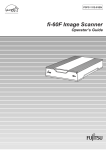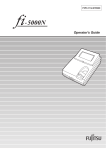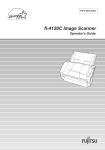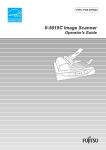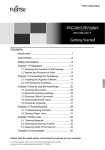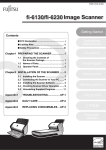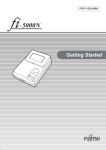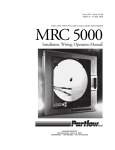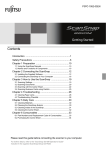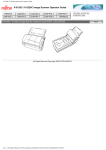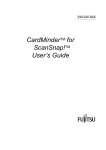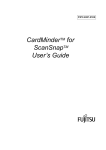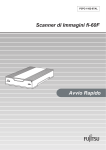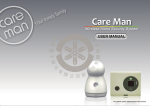Download fi-60F Image Scanner
Transcript
P3PC-1112-07ENZ0 fi-60F Image Scanner Operator's Guide CONTENTS INTRODUCTION............................................................................ iii ■ Regulatory Information ........................................................ iii ■ Note, Liability ........................................................................ vi ■ Safety Precautions ............................................................. viii Chapter 1 BASIC SCANNER OPERATIONS............................ 1 1.1 Turning the Scanner ON .................................................... 2 1.2 Loading Documents on the Scanner for Scanning ......... 3 1.3 How to Use the Scanner Driver ......................................... 5 1.4 Correcting skewed documents ....................................... 18 1.5 Excluding a Color in the Image (dropout color) ............ 20 Chapter 2 DAILY CARE .......................................................... 23 2.1 Cleaning Materials ............................................................ 24 2.2 Cleaning the Scanner ....................................................... 24 Chapter 3 TROUBLESHOOTING............................................ 27 3.1 Remedying Typical Troubles........................................... 28 3.2 Items to Check Before Contacting the Agent Where You Bought the Scanner.......................................................... 34 3.3 Checking the Label on the Scanner................................ 36 fi-60F Image Scanner Operator’s Guide i Chapter 4 SCANNER SPECIFICATION .................................. 37 4.1 Basic Specifications......................................................... 38 4.2 Installation Specifications ............................................... 39 4.3 External Dimensions ........................................................ 40 INDEX ........................................................................................ IN-1 ii INTRODUCTION Thank you for purchasing the fi-60F Scanner product. This document describes how to handle fi-60F Scanner and basic operation methods. Before you start using fi-60F Scanner be sure to thoroughly read this manual to ensure correct use. ■Regulatory Information FCC Declaration This equipment has been tested and found to comply with the limits for a Class B digital device, pursuant to Part 15 of the FCC Rules. These limits are designed to provide reasonable protection against harmful interference in a residential installation. This equipment generates, uses, and can radiate radio frequency energy and, if not installed and used in accordance with the instruction manual, may cause harmful interference to radio communications. However, there is no guarantee that interference will not occur in a particular installation. If this equipment does cause harmful interference to radio or television reception, which can be determined by turning the equipment off and on, the user is encouraged to try to correct the interference by one or more of the following measures: •Reorient or relocate the receiving antenna. •Increase the separation between the equipment and receiver. •Connect the equipment into an outlet on a circuit different from that to which the receiver is located. •Consult your dealer or an experienced radio/TV technician. FCC warning: Changes or modifications not expressly approved by the party responsible for compliance could void the user’s authority to operate the equipment. The use of a shielded interface cable is required to comply with the Class B limits of Part 15 of FCC rules. The length of the AC cable must be 2 meters (6.6 feet) or less. fi-60F Image Scanner Operator’s Guide iii Canadian DOC Regulations This digital apparatus does not exceed the Class B limit for radio noise emissions from digital apparatus set out in the Radio interference Regulations of the Canadian Department of Communications. This Class B digital apparatus complies with Canadian ICES-003. Le présent appareil numérique n’émet pas de bruits radioélectriques dépassant les limites applicables aux appareils numériques de la classe B prescrites dans le règlement sur le brouillage radioélectrique dicté par le Ministère des Communications du Canada. Cet appareil numérique de classe B est conforme à la norme NMB-003 du Canada. Bescheinigung des Herstellers / Importeurs Für den fi-60F wird folgendes bescheinigt: •In Übereinsstimmung mit den Bestimmungen der EN45014(CE) funkentstört •Maschinenlärminformationsverordnung 3.GPSGV: Der höchste Schalldruckpegel beträgt 70 dB (A) oder weniger, gemäß EN ISO 7779. Use in High-safety Applications This product has been designed and manufactured on the assumption that it will be used in office, personal, domestic, regular industrial, and general-purpose applications. It has not been designed and manufactured for use in applications (simply called "high-safety applications" from here on) that directly involve danger to life and health when a high degree of safety is required, for example, in the control of nuclear reactions at nuclear power facilities, automatic flight control of aircraft, air traffic control, operation control in mass-transport systems, medical equipment for sustaining life, and missile firing control in weapons systems, and when provisionally the safety in question is not ensured. The user should use this product with adopting measures for ensuring safety in such highsafety applications. PFU LIMITED assumes no liability whatsoever for damages arising from use of this product by the user in high-safety applications, and for any claims or compensation for damages by the user or a third party. Dieses Gerät wurde nicht für die Benutzung in unmittelbarer Umgebung starker Lichtquellen (z. B.Projektoren) konzipiert. Trademarks Microsoft, Windows, Windows Server, Windows Vista, and SharePoint are either registered trademarks or trademarks of Microsoft Corporation in the United States and/or other countries. ISIS and QuickScan are trademarks or registered trademarks of EMC Corporation in the United States. Adobe, the Adobe logo, Acrobat, and Adobe Reader are either registered trademarks or trade names of Adobe Systems Incorporated in the United States and/or other countries. Other company names and product names are the registered trademarks or trademarks of the respective companies. iv How Trademarks Are Indicated In This Manual References to operating systems (OS) are indicated as follows: Windows 2000: Windows® 2000 Professional operating system Windows XP: Windows® XP Home Edition operating system, Windows® XP Professional operating system (32/64-bit) Windows Server 2003: Windows Server® 2003, Standard Edition (32/64-bit), Windows Server® 2003 R2, Standard Edition (32/64-bit) Windows Vista: Windows Vista® Home Basic operating system (32/64-bit), Windows Vista® Home Premium operating system (32/64-bit), Windows Vista® Business operating system (32/64-bit), Windows Vista® Enterprise operating system (32/64-bit), Windows Vista® Ultimate operating system. (32/64-bit) Windows Server 2008: Windows Server® 2008 Standard (32/64-bit), Windows Server® 2008 R2 Standard Windows7: Windows® 7 Home Premium operating system (32/64-bit), Windows® 7 Professional operating system (32/64-bit), Windows® 7 Enterprise operating system (32/64-bit), Windows® 7 Ultimate operating system (32/64-bit) Where there is no distinction between the different versions of the above operating system, the general term "Windows" is used. Manufacturer PFU LIMITED International Sales Dept., Imaging Business Division, Products Group Solid Square East Tower, 580 Horikawa-cho, Saiwai-ku, Kawasaki-shi Kanagawa 212-8563, Japan Phone: (81-44) 540-4538 © PFU LIMITED 2004-2011 fi-60F Image Scanner Operator’s Guide v ■Note, Liability BEFORE USING THIS PRODUCT, PLEASE READ THIS MANUAL CAREFULLY. IF THIS PRODUCT IS NOT USED CORRECTLY, UNEXPECTED INJURY CAN OCCUR TO USERS OR BYSTANDERS Keep this manual in a safe place so that it can be easily referred to during use of this product. While all efforts have been made to ensure the accuracy of all information in this manual, PFU assumes no liability to any party for any damage caused by errors or omissions or by statements of any kind in this manual, its updates or supplements, whether such errors are omissions or statements resulting from negligence, accidents, or any other cause. PFU further assumes no liability arising from the application or use of any product or system described herein; nor any liability for incidental or consequential damages arising from the use of this manual. PFU disclaims all warranties regarding the information contained herein, whether expressed, implied, or statutory. Warning Indications Used In This Manual This indication alerts operators to an operation that, if not strictly observed, may result in severe injury or death. This indication alerts operators to an operation that, if not strictly observed, may result in safety hazards to personnel or damage to equipment. Symbols Used In This Manual This symbol alerts operators to particularly important information. Be sure to read this information. This symbol alerts operators to helpful advice regarding operation. A TRIANGLE symbol indicates that special care and attention is required. The drawing inside the triangle shows the specific caution. A CIRCLE with a diagonal line inside shows action which users may not perform. The drawing inside or under the circle shows the specific action that is not allowed. vi Outline characters on a colored background show instructions users should follow. It may also include the drawing that shows the specific instruction. Screen Examples In This Manual The screen examples in this manual are subject to change without notice in the interest of product improvement. If the actual displayed screen differs from the screen examples in this manual, operate by following the actual displayed screen while referring to the User's Manual of the scanner application you are using. The screenshots in this manual were captured from the TWAIN scanner driver, ScandAll PRO Lite Image Capturing Utility Software, ISIS scanner driver and QuickScan™ image capturing software . About Maintenance The user must not perform repairs on this scanner. Contact the store where you purchased the scanner or an authorized FUJITSU Image Scanner service provider to have repairs done on this product. fi-60F Image Scanner Operator’s Guide vii ■Safety Precautions In the following warnings, "power cable" may refer to the AC cable connected to the AC adapter collectively. Do not damage the AC cable. A damaged AC cable may cause fire or electric shock. Be careful of the following when handling the power cable: • Do not moisten, modify, tie, bundle, or wind the cable. • Do not place heavy objects on the cable, trap the cable in a doorway, drop or damage the cable in any other way. • Do not pull or forcibly bend or twist the cable. • Do not place any metal near to the plug of the power cable. Do not use damaged AC cables or power plugs, or install any cables or power plugs to loose wall sockets. Use only specified AC cables and connector cables. Use only specified AC cables and connector cables. Failure to use the correct cables might cause electric shock and/or equipment failure. Do not use the AC cable provided with this scanner with other devices, since this may cause equipment failure or electric shock. Use this scanner only at the indicated power voltage. Do not connect to multiple-power strips. Use this scanner only at the indicated power voltage and current. Improper power voltage and current might cause fire or electric shock. Do not connect to multiple-power strips. Do not touch the AC cable with wet hands. Do not touch the power plug with wet hands. Doing so can cause electric shock. Wipe any dust from the power plug. Wipe off any dust from the power cable, metal parts on the power plug or metal fittings with a soft, dry cloth. Accumulated dust can cause fire or electric shock. viii Do not install the device in locations that has oil smoke, steam, humidity, and dust. Do not install the scanner in locations subject to oil smoke, steam, humidity, and dust. Doing so might cause a fire or electric shock. Turn the scanner OFF if it is damaged. If the scanner is damaged for any reason, immediately unplug the power cable to turn off the scanner. Contact the store where you purchased the scanner. Do not put liquids inside the scanner. Do not insert or drop metal objects in to the scanner. Do not scan wet documents or documents with paper clips or staples. Do not splash or allow the scanner to get wet. If foreign objects (water, small metal objects, liquids, etc.) get inside the scanner, immediately unplug the power cable to turn off the scanner. Then, contact the store where you bought the scanner or the Maintenance Service Center. Pay particular attention to this warning in households where there are small children. Do not touch the inside of the scanner unless necessary. Do not take apart or modify the scanner. The inside of the scanner contains highvoltage components. Touching these components might cause electric shock or fire. Do not use the scanner if there is a strange odor. If you detect excessive heat coming from the device or detect other problems such as smoke, strange smells or noises, immediately unplug the power cable to turn off the scanner. Make sure that any smoke coming from it has stopped, before contacting the store where you bought the scanner or an authorized FUJITSU scanner service provider. Do not use aerosol sprays near the scanner. Do not use any aerosol sprays or alcohol based sprays to clean the scanner. Dust blown up by strong air from the spray may enter the inside of the scanner. This may cause the scanner to fail or malfunction. Sparks, caused by static electricity, generated when blowing off dust and dirt from the outside of the scanner may cause a fire. fi-60F Image Scanner Operator’s Guide ix Do not install the scanner on unstable surfaces. Make sure that the scanner is installed on a flat, level surface and that none of its parts extend beyond the surface top, such as a desk or table. Do not install the scanner on unstable surfaces. Install the scanner on a level surface that is free of vibration to prevent it from falling. Install the scanner on a strong surface that will support the weight of the scanner and other devices. Do not place heavy objects or stand on top of the scanner. Do not place heavy objects on the scanner or use the scanner's surface top to perform other work. Improper installation might cause injuries and equipment failure. Firmly insert the power plug. Firmly insert the power plug as far it can go into the power outlet. Do not use the scanner immediately after moving it from a cold place into a warm room. Do not use the device immediately after moving it from a cold place into a warm room. Condensation may occur, which might lead to scanning errors. Let the device dry about one or two hours before you use it. Before moving the scanner, disconnect the power plug from the power outlet. Do not move the scanner with the power and interface cables connected as this can damage the cables, which can later cause fire, electric shock as well as injury. Before moving the scanner, be sure to disconnect the power plug from the power outlet, and all other data cables. Make sure that the floor is free of any obstructions. Protect the scanner from static electricity. Install the scanner away from strong magnetic fields and other sources of electronic noise. Also, protect the scanner against any static electricity, which can cause the scanner to malfunction. x Disconnect the power plug from the power outlet when the scanner is not used for a long period of time. When the scanner is not going to be used for a long period of time, be sure to disconnect the power plug from the power outlet. Do not install the scanner in direct sunlight. Do not install the scanner under direct sunlight or near heating apparatus. Doing so might cause excessive heat to build up inside the scanner, which can cause scanner trouble or even fire. Install the scanner in a well-ventilated location. Before moving the scanner, make sure the shipping lock is locked. When moving the scanner, be sure to lock the shipping lock in order to prevent damages to the scanner. fi-60F Image Scanner Operator’s Guide xi xii Chapter 1 1 BASIC SCANNER OPERATIONS This chapter describes basic scanner operations. In this chapter Windows XP screenshots are illustrated. The screens and operations may differ slightly if the OS that you are using is not Windows XP. Also, when TWAIN or ISIS is updated the screens and operations noted in this chapter will differ slightly. 1.1 Turning the Scanner ON .................................................................................... 2 1.2 Loading Documents on the Scanner for Scanning ......................................... 3 1.3 How to Use the Scanner Driver ......................................................................... 5 1.4 Correcting skewed documents ....................................................................... 18 1.5 Excluding a Color in the Image (dropout color) ............................................ 20 fi-60F Image Scanner Operator’s Guide 1 1.1 Turning the Scanner ON Because the power supply of this scanner is linked to the power supply of your PC, fi-60F is not equipped with a separate power button or switch. If you keep connecting the AC adapter to the the scanner, plugging the AC cable into a power outlet, and connecting the scanner to your PC, you can use the scanner without reminding of the switching. If you turn on your PC... The Scanner LED lights when starting up Windows (Scanner turned on) If you turn off your PC... The Scanner LED goes out when shutting down Windows (Scanner turned off) You can also turn off the scanner by doing the following: • Disconnect the USB cable from the scanner or PC. • Disconnect the AC adapter from the scanner. • Unplug the AC cable from the power outlet or the AC adapter. ■ Power Save Mode The Power Save mode keeps the scanner in a low-powered state after it has been turned ON. If no operation is performed on the scanner for 15 minutes, the scanner automatically switches to the Power Save mode. To return from the Power Save mode, perform a scan using the scanner driver. 2 1.2 Loading Documents on the Scanner for Scanning 1.2 Loading Documents on the Scanner for Scanning 1. Lift up the document cover. 1 BASIC SCANNER OPERATIONS For Breakage prevention, the document cover may come off if you open the document cover too much. If it comes off, pull out the hinge pins from the scanner once, set them to the document cover shaft, then install the document cover to the scanner. Shaft Hinge pin fi-60F Image Scanner Operator’s Guide 3 2. Load the document on the document bed with the scanning face down and the top left corner aligned to the reference point. 3. Gently close the document cover. 4. Start up the scanner application, and scan the document. For details on how to scan documents see "1.3 How to Use the Scanner Driver" (page 5). • You can pull out the document cover from the scanner when you scan the thick document like a book. In such a case, press down the document from the top, let it stick to the document bed firmly. <Attention> Be careful of the following points: The scanned image will become blurred if the document loses touch with the document bed by curl, crease, etc. . Because of opening the document cover, the light from an indoor fluorescent light may penetrate the document, and may affect the brightness of image data. (The thinner document is, the more it is influenced.) In such a case, scan the document with closing the document cover. • Do not disconnect the USB cable or AC adapter from the scanner when the scanning operation is ongoing. 4 1.3 How to Use the Scanner Driver 1.3 How to Use the Scanner Driver ■ TWAIN Scanner Driver TWAIN Scanner Driver is designed for scanning documents with FUJITSU image scanner fi series by using application software that complies with the TWAIN standard. The following describes the procedure with examples of ScandAll PRO Lite for ordinary scanning by using this driver software. BASIC SCANNER OPERATIONS Using the TWAIN Scanner Driver for scanning 1) Startup the application. From the [Start] menu, select [All Programs]-[Fujitsu ScandAll PRO Lite] and click [Fujitsu ScandAll PRO Lite]. 2) Select your scanner on the window below. Select [Select Source] from the [Scan] menu. 3) Select the scanner to use, then click the [Select] button. Select [FUJITSU fi-60F], then click the [Select] button. 4) Load the documents on the scanner. For details on loading documents, refer to "1.2 Loading Documents on the Scanner for Scanning" (page 3). fi-60F Image Scanner Operator’s Guide 1 5 5) Open the TWAIN Driver window. Select [To View] from the [Scan] menu. ScandAll PRO Lite provides scanning methods as follows: • [To View...]: Displays scanned images on the window. • [To File...:]: Saves scanned images as files (*.BMP, *.TIF, *.JPG). • [To Ftp...:]: Transfers scanned images to a FTP server. • [To Adobe PDF...:]: Saves scanned images as PDF files. (*Adobe Acrobat (sold separately) must be installed beforehand.) • [To Microsoft SharePoint Server...]: Transfers scanned images to Microsoft SharePoint Server. • [To Mail...]: Launches mailer software and attaches scanned images to email. For details, refer to "ScandAll PRO Lite Help". 6) Configure settings for scanning and click the [Scan] button. For details about the settings on this window, refer to "Setting Window for TWAIN Scanner Driver" (page 8). ⇒ The images of scanned documents are displayed on the [ScandAll PRO Lite] window. 6 1.3 How to Use the Scanner Driver 1 7) Save the scanned images. Select [Save As...] from the [File] menu to save the scanned images. If you wish to start another scanning, return to procedure 4. 8) End the application. Select [Exit] from the [File] menu. fi-60F Image Scanner Operator’s Guide 7 BASIC SCANNER OPERATIONS Depending on the settings of the application software, images may not be displayed. For details, refer to the documentation or Help file of your application. e.x.) When you select [To File...] from the [Scan] menu of ScandAll PRO Lite, images of scanned documents are not displayed on the window. Setting Window for TWAIN Scanner Driver You can configure settings for the TWAIN Scanner Driver on this window. The following describes the main setting items. • For details on each functions, refer to "TWAIN Scanner Driver Help" (appears by clicking the [Help] button or pressing the [F1] key). • Depending on the type of your scanner, available setting items or range of setting values vary. Resolution Specifies the resolution of scanning. It can be specified by selecting a default value from the list or customizing (specify any resolution in 1 dpi unit). By marking the [Predefine] checkbox, you can select one from three predefined settings as [Normal], [Better], [Best] to scan documents instead of setting details by yourself. Otherwise, you can change the details of the predefined settings on the [Resolution Setting] window, which appears when you click on the [...] button. Paper Size Select the size of documents to be scanned from this list. Windows for customizing the paper size will appear when you click on [...] besides the list. You can save any document size as a customized setting (up to three) or for changing the order of the paper size in the list. 8 1.3 How to Use the Scanner Driver Image Mode Specifies the image type for the scanned documents. Black & White Documents are scanned in binary (black and white). Halftone Documents are scanned through halftone processing in black and white. Grayscale Documents are scanned in gradations from black to white. For this mode you can select 256 gradations or 4 bit (16 gradations). Color Documents are scanned in color. For this mode, you can select 24 bit Color, 256 Color or 8 Color. 1 [Preview] button Documents are scanned preliminarily before the actual scanning. You can confirm the image of the documents in the preview window. [Close] button Saves the current settings and closes this window. [Reset] button Used to undo changes of settings. [Help] button Opens the "TWAIN Scanner Driver Help" window. The window also opens by pushing the [F1] key. [About...] button Opens an information window about the TWAIN Scanner Driver's version. fi-60F Image Scanner Operator’s Guide 9 BASIC SCANNER OPERATIONS [Scan] button Starts scanning documents with the current settings. [Option...] button You can set up the details of optional functions on the window below. [Rotation] tab Select this tab when setting image rotation and detection of document size. [Generic] tab Select this tab to change the unit of the size displayed on the Setting Window for the TWAIN Scanner Driver. (Millimeters, Inches, and Pixels are available) [Filter] tab Select this tab for setting the image processing filter(s). Page Edge Filler: Fills up the margins of the scanned documents with a selected color. Digital Endoser: A character string, such as the alphabet and numbers, can be added in the scanned document. [Advance...] button Click this button for settings of the advanced image processing. You can set Edge Extract, Gamma Pattern, White Level Follower, Dropout Color, Reverse, etc. [Config...] button Click this button for configuring the Setting Files. You can save the changed settings as a Setting File. From next scanning, the settings are quickly changed by using these Setting Files. For details of each function, refer to the "TWAIN Scsnner Driver Help". 10 1.3 How to Use the Scanner Driver ■ ISIS Scanner Driver ISIS Scanner Driver is designed for scanning documents with FUJITSU image scanner fi series by using application software that complies with The ISIS standard. The following describes the procedure with examples of QuickScan for ordinary scanning by using this driver software. The procedure may vary depending on your application. If you use an application other than QuickScan, please refer to its Guide or Help for further information. 1) Startup the application. From the [Start] menu, select [All Programs] -[EMC Captiva] - [QuickScan] and click [QuickScan]. 2) Select your scanner on the window below. Select [Scan] - [Select Scanner] on the menu bar. 3) Select [Fujitsu fi-60F], then click the [OK] button. 4) Select [Scan] - [New Batch] on the menu bar. fi-60F Image Scanner Operator’s Guide 11 BASIC SCANNER OPERATIONS Using the ISIS Scanner Driver for Scanning 1 5) Select the profile for scanning. • • • When creating a new profile Select one from existing profiles and click [Add...] button. ⇒ A new profile will be created based on the profile you select. When changing the settings of already existing profiles Select one from existing profiles and click [Edit...] button. ⇒ The settings of the selected profile can be changed. When using an existing profile Select one from an existing profiles. ⇒ Scanning will be started according to the settings of the selected profile. Go to procedure 9. 6) Open the window of ISIS Driver. Select the [Scan] tab and click the [Scanner Settings...] on the [Scan Profile Editor] window. ⇒ The configuration window of ISIS driver appears. 12 1.3 How to Use the Scanner Driver 7) Configure settings for scanning and click the [OK] button. 1 8) The [Scan Profile Editor] window appears. Click the [OK] button to return to [New Batch] dialog. 9) Load the documents on the scanner. 10) Click the [Scan] button. ⇒ Scanned images are displayed on the window. Refer to the "QuickScan Overview" or the "QuickScan Help" for further information on functions and operations of QuickScan. After the installation of QuickScan, it is registered in the [Start] menu. fi-60F Image Scanner Operator’s Guide 13 BASIC SCANNER OPERATIONS For details on this dialog box, refer to "Configuration Window of ISIS Scanner Driver" (page 14). Configuration Window of ISIS Scanner Driver Image Mode Select a color mode suitable for the purpose from the menu. Black & White Scans data in binary (black and white). Distinguishes black from white according to the fixed threshold. This scanning mode is suitable for scanning line drawings and text documents. 16-level Grayscale Scans data to 16 shades of gray. 256-level Grayscale Scans data to 256 shades of gray. This mode uses 8 bits per pixel. This mode is suitable for scanning monochrome photographs. 24-bit Color Scans data as full-colored image using 24 bits per pixel. This mode is suitable for scanning color photographs. Image Processing Binary processing is applied to the scanned images. This mode is available only when Image Processing Software Option (separately sold) is installed. Please refer to the "User’s Guide of Image Processing Software Option" for details. Resolution Specifies the number of pixels (dots) per inch. Select a fixed resolution from the list or enter any value (from 50 to 600) manually. A higher resolution produces finer image, but requires much more memory. 14 1.3 How to Use the Scanner Driver Brightness Sets the brightness of the entire image. Specify the brightness as a number within the range of 1 (dark) to 255 (bright). To brighten the entire image, increase the value of the setting. To darken the entire image, decrease the value. Contrast Sets the contrast between light and shadow of the scanned image. Specify the contrast as a number within the range of 1 (low [soft]) to 100 (high [sharp]). Increasing this value makes the contrast sharper. Paper Size Selects a paper size according to the size of the document to be scanned. Select a standard paper size from the list. Automatic Size and Skew detection This option will adjust the output to the detected page size, and it will detect and automatically correct the skew of the document. fi-60F Image Scanner Operator’s Guide 15 1 BASIC SCANNER OPERATIONS Halftone Select the halftone pattern for halftone scanning. This setting is available when "Black & White" is selected in the "Image Mode". Dither Pattern 0 This setting is suitable for scanning dark photographs. Dither Pattern 1 This setting is suitable for scanning dark-colored documents containing both text and photographs. Dither Pattern 2 This setting is suitable for scanning light photographs. Dither Pattern 3 This setting is suitable for scanning light-colored documents containing both text and photographs. Error Diffusion This function minimizes differences of color levels due to subtractive color process by diffusing the difference to the adjacent pixels. This mode is suitable for scanning images of photographs, etc. Download Executes processing with the dithered download pattern specified in the dithered download file. [Area...] button Opens the Scan Area dialog box. Specify scan area for the document size. The size can be set by dragging the frame with mouse. Otherwise, enter any value for the setting. [About...] button This button displays the version information. [More...] button Opens [More Settings] window. Used for setting advanced features. Gamma You can select a pattern from [Normal], [Soft], [Sharp], [Download], [Custom] and [Bright]. DTC Variance This option specifies the value for adjusting the variance based on the brightness of the image. 16 1.3 How to Use the Scanner Driver Edge Processing This option specifies the sharpness of contour extraction. Low, Mid, High Emphasizes contour of images. Available settings are: Low, Mid, High Smoothing Smoothes jaggy images. Reverse Colors of scanned images are reversed. fi-60F Image Scanner Operator’s Guide 17 1 BASIC SCANNER OPERATIONS Dropout Color This option excludes a selected color (the three primary colors of light i.e. green, red, blue) from scanned images. For example, if the document contains black text in a red frame and when the red color is selected, the scanner reads only the text and eliminate (drop out) the red frame. If you do not wish to have any colors dropped out select "None". 1.4 Correcting skewed documents You can set the scanner so that skew of documents are detected and corrected automatically when skewed documents are fed into the ADF. Change the setting in the [TWAIN Driver] dialog box to enable this function. The following shows the procedure for changing the setting in the dialog box: 1. Click [Option] button in the [TWAIN Driver] dialog box. ⇒ The [Option] dialog box appears. 2. Click the [Rotation] tab. 3. Select the [Automatic page size detection ] from the [Automatic Size and Skew Detection] menu. 4. Click the [OK] button. The display returns to [TWAIN Driver] dialog box. Perform the scanning operation on the dialog box. 18 1.4 Correcting skewed documents When using either of the following documents, the automatic page size detection may not function correctly: • Not rectangular documents • Documents which their edges are filled 1 BASIC SCANNER OPERATIONS fi-60F Image Scanner Operator’s Guide 19 1.5 Excluding a Color in the Image (dropout color) A selected color (primary colors: red, green or blue) can be removed (dropped out) from the scanned image data. For example, if the document contains black text in a green frame, you can set the scanner to read only the text and eliminate (drop out) the green frame. To set the scanner to drop out a color, change the settings in the [TWAIN Driver] dialogbox before scanning. Dropout color is only available in black & white or grayscale mode. 1. Click the [Advance...] button in the [TWAIN Driver] dialog box. ⇒ The [Advance] dialog box appears. 2. Select the color to be drop out from [Dropout Color] under [More]. For example, if the document contains black text in green frame, select [Green] so that the scanner only reads the text and eliminates the frames. If you do not wish to have any colors dropped out select "None". 20 1.5 Excluding a Color in the Image (dropout color) 1 fi-60F Image Scanner Operator’s Guide 21 BASIC SCANNER OPERATIONS 3. Click the [OK] button. The [TWAIN Driver] dialog box will be redisplayed. Continue scanning from this dialog box. 22 Chapter 2 DAILY CARE This chapter describes how to clean the scanner. 2 Do not use any aerosol sprays or alcohol based sprays to clean the scanner. Dust blown up by strong air from the spray may enter the inside of the scanner. This may cause the scanner to fail or malfunction. Sparks, caused by static electricity, generated when blowing off dust and dirt from the outside of the scanner may cause a fire. 2.1 Cleaning Materials............................................................................................ 24 2.2 Cleaning the Scanner....................................................................................... 24 fi-60F Image Scanner Operator’s Guide 23 2.1 Cleaning Materials The table below shows the cleaning materials that are used on this scanner. Cleaning Materials Part No. Remarks Cleaner F1 PA03950-0352 (*1) 1 bottle (100 ml) Moisten cloth with this fluid and wipe the scanner clean. Cleaning Wipe PA03950-0419 24 sheets/pack Pre-moistened with Cleaner F1, Cleaning Wipes are used instead of moistened cloths. PFU LIMITED Soft, dry, lint-free cloth Any commercially available cloth For details on Cleaner F1, consult the agent where you bought your scanner. *1) It may take long before the cleaner vaporizes if a large quantity is used. When cleaning the scanner parts, dampen a cloth with modest quantities of the cleaner. In addition, wipe off the cleaner completely with a soft lint-free cloth to leave no residue on the surface of the cleaned parts. 2.2 Cleaning the Scanner Any detergent for cleaning windows or glass cleaner can be used instead of F1 fluid. However, do not use paint thinner or other organic solvents. The following parts needs to be cleaned: • Document holding pad • Document bed 24 2.2 Cleaning the Scanner Document cover Document holding pad Document bed 2 DAILY CARE 1. Open the document cover. fi-60F Image Scanner Operator’s Guide 25 2. Clean the following locations using a soft, dry cloth moistened with cleaning fluid. Document holding pad Document bed • Document holding pad Wipe gently. • Document bed Wipe lightly. • Do not allow moisture to get inside the device during cleaning. • It may take long before the cleaner vaporizes if a large quantity is used. When cleaning the scanner parts, dampen a cloth with modest quantities of the cleaner. In addition, wipe off the cleaner completely with a soft lint-free cloth to leave no residue on the surface of the cleaned parts. 3. Wait for cleaned parts to dry. 4. Gently close the document cover. 26 Chapter 3 TROUBLESHOOTING This chapter describes how to remedy troubles, items to check and how to check device labels before contacting the agent where you bought the scanner. About troubles that are not described here, and the details of the errors, refer to the TWAIN Scanner Driver Help. 3 3.1 Remedying Typical Troubles .......................................................................... 28 3.2 Items to Check Before Contacting the Agent Where You Bought the Scanner.............................................................................................................. 34 3.3 Checking the Label on the Scanner ............................................................... 36 fi-60F Image Scanner Operator’s Guide 27 3.1 Remedying Typical Troubles This section describes troubles that may occur during scanning and how to remedy that trouble. Before you ask for repair, check the following flowcharts. If the remedies in these flowcharts do not solve the problem, check the items in "3.2 Items to Check Before Contacting the Agent Where You Bought the Scanner" (page 32) and then contact the agent where you bought the scanner. Symptom 1 Scanner cannot be turned ON. Are power cable, the AC adapter and the USB cable correctly connected? NO Correctly connect power cable, USB cable and the AC adapter. YES NO Is your PC turned on? Turn on your PC. YES Is the Scanner driver installed correctly? YES If you cannot solve the problem after taking measures, check the items in "3.2 Items to check before contacting the dealer where you bought the scanner" and contact the dealer or an authorized FUJITSU service provider. 28 NO Install the Scanner driver correctly. Refer to "2.1 Installing the Scanner Application" of Getting Started. 3.1 Remedying Typical Troubles Symptom 2 The scanning does not start. Did you unlock the shipping lock of the flatbed? NO Turn OFF the scanner and unlock the shipping lock. (*1) NO Connect the USB cable correctly. (*2) If you use an USB hub, connect the scanner directly to your PC. YES Is the USB cable connected correctly? YES Is the connector of the USB cable broken? YES Use a new USB cable and correctly connect it. NO Does the scanning start after running ON the PC again? YES The scanner operation is normal. 3 NO TROUBLESHOOTING If you cannot solve the problem after taking measures, check the items in "3.2 Items to check before contacting the dealer where you bought the scanner" and contact the dealer or an authorized FUJITSU service provider. *1) For details, refer to "Getting Started" 2.2 Installing the Scanner. *2) For details, refer to "Getting Started" 2.3 Connecting the scanner to your PC. fi-60F Image Scanner Operator’s Guide 29 Symptom 3 Images are distorted or blurred. Are the document bed, and the document holding pad clean? NO Clean the dirty locations. (*) YES Do not allow anything to cause the scanner to vibrate while scanning. YES Is something causing the scanner to vibrate during scanning? NO Is the scanner installed on a flat, level surface? NO Install the scanner on a flat, level surface. YES Is the document curled or folded? YES Place the document flat and hold it down slightly with the document cover. NO If you cannot solve the problem after taking measures, check the items in "3.2 Items to check before contacting the dealer where you bought the scanner" and contact the dealer or an authorized FUJITSU service provider. *) For details on how to clean dirty locations, see "Chapter 2 DAILY CARE" (page 21). 30 3.1 Remedying Typical Troubles Symptom 4 There is a shadow on the leading edge of the scanned images. Did you adjust the offset (starting position for scanning the document)? YES Check the items in "3.2 Items to check before contacting the dealer where you bought the scanner" and contact the dealer or an authorized FUJITSU service provider. NO Adjust the offset. Display the properties of the scanner that you are using on "Scanners and Cameras" in the control panel, then select [Device Set] - [Offset] button and adjust the [Sub-scan Setting]. 3 TROUBLESHOOTING fi-60F Image Scanner Operator’s Guide 31 Symptom 5 When the document is scanned in Black & White mode, the image generated becomes black. Are the Document holding pad and the Document bed of the scanner clean? NO Clean the unclean part (*1) YES Have you tried to adjust the settings of the scanner driver (Threshold or Brightness)? NO Adjust the Threshold and/or Brightness. YES Do you scan a thin document that the contents of the backside is seen through? YES Place a piece of white paper behind the document and scan again.(*2) NO If you cannot solve the problem after taking measures, check the items in "3.2 Items to Check Before Contacting the Agent Where you Bought the Scanner" and contact the dealer or an authorized FUJITSU service provider. *1) For cleaning the unclean part, see Chapter 2 DAILY CARE. *2) - When there is any contents such as characters on the backside of the document, it may be seen through and appeared in the scanned image. - When using "Automatic Size and Skew detection", lap over the document with a white paper of the same size of the document. 32 3.1 Remedying Typical Troubles Symptom 6 Automatic papersize detection is failed. NO Are the Document holding pad and the Document bed of the scanner clean? Clean the unclean part (*1) YES NO Did you scan with the document cover closed? Close the document cover and scan it again. YES Does the document have rectangular or square shape ? NO If the document is other than rectangular or square, the scanner may fail to detect the size correctly. YES YES Did you scan a document with any corner folded? 3 If the corner is folded, unfold it. TROUBLESHOOTING NO YES Did you scan a document with the edge(s) colored in dark? If the document has the edge(s) colored in dark, the scanner may fail to detect the size correctly. NO If you cannot solve the problem after taking measures, specify the area to scan in the driver setting window manually and scan it again. See ".1.3 How to Use the Scanner Driver" *1) For cleaning the unclean part, see Chapter 2 DAILY CARE. fi-60F Image Scanner Operator’s Guide 33 3.2 Items to Check Before Contacting the Agent Where You Bought the Scanner Check the following items before you contact the agent where you bought the scanner. ■ General Details Item Model (Example) fi-60F For details on model, see "3.3 Checking the Label on the Scanner" (page 34). Serial No. (Example) 000001 For details on serial No., see "3.3 Checking the Label on the Scanner" (page 34). Production date (Example) 2007-12 (December, 2007) For details on production date, see "3.3 Checking the Label on the Scanner" (page 34). Date of purchase Symptom Frequency of trouble 34 findings 3.2 Items to Check Before Contacting the Agent Where You Bought the Scanner ■ Installation or PC connection issues ■ Problem at the time of personal computer connection Item findings OS (Windows) Displayed error message Interface USB 2.0 Interface controllers (Example) Made by Intel, 82801EB ■ Imaging system trouble Item findings Type and version of scanner driver Type of interface controller (Example) Made by Intel, 82801EB OS (Windows) Application software 3 (Example) ScandAll PRO Lite TROUBLESHOOTING ■ Other Item findings Can the scanner image and the document be sent by e-mail or Fax? fi-60F Image Scanner Operator’s Guide 35 3.3 Checking the Label on the Scanner This section describes how to check the label on the scanner. ■ Position of the Labels on the Scanner (scanner bottom) The following shows where the labels are located on the scanner. Label A (example): Indicates various standards that the scanner conforms with. Label B (example): Indicates scanner information. 36 Chapter 4 SCANNER SPECIFICATION 4 This chapter lists the scanner specifications. 4.1 Basic Specifications......................................................................................... 38 4.2 Installation Specifications ............................................................................... 39 4.3 External Dimensions........................................................................................ 40 fi-60F Image Scanner Operator’s Guide 37 4.1 Basic Specifications 1 Scanner Type Flatbed 2 Image sensor Color Contact Image Sensor (CMOS IC) 3 Light source Three LEDs (RGB) 4 Scanning area Maximum Scanning Speed 5 (Note (*1)) - 148 x105mm 5.8 in X 4.13 in A6 Binary (monochrome) 1.0 sec 200 dpi, max size USB 2.0 Color 1.3 sec 150 dpi max size USB 2.0 - 6 Optical Resolution 600 dpi - 7 Output resolution Binary (monochrome) 50 - 600 dpi Scalable in 1 dpi increments Grayscale 50 - 600 dpi Scalable in 1 dpi increments Color 50 - 600 dpi Scalable in 1 dpi increments 8 Grayscale level (internal) 8 bits per color Internal 16 bits 9 Halftone Patterns Dither / error diffusion - 10 Interface (Note (*2)) USB 2.0 / 1.1 B type *1) The scanning speed is the maximum speed of the scanner hardware. Software processing time such as data transfer time is added to the actual scanning time. *2) If you connect the scanner with USB 2.0, it is required that the USB port and the Hub are compliant with USB 2.0. The scanning speed may slow down when you connect the scanner with USB 1.1. If your computer has the compatible USB 2.0 port, please use it. 38 4.2 Installation Specifications 4.2 Installation Specifications Item Dimensions (mm) (just the scanner, document cover closed) Installation Space (mm) Specification Depth 234 (9.21 in) Height 40 (1.58 in) Width 145 (5.71 in) Height 257 (10.12 in) 4 0.9 (2 lbs) Voltage 100 to 120 VAC ±10% 220 to 240 VAC ±10% Phases Single-phase Frequency 50 / 60 ± 3Hz Power consumption SCANNER SPECIFICATION Input power 145 (5.71 in) Depth 281 (11.06 in) Weight (kg) Width Operating : 8W Stand by: 2W Low Power Mode: 1W Installation Space is the reference value of an installation space required for opening and closing the document cover. Item Ambient condition Specification Device status Operating Not operating Temperature 5 to 35 °C (42 to 95°F) -20 to 60 °C (-4 to 140°F) Humidity 20 to 80 % (no condensation) 8 to 95 % Heat capacity 6.1 kcal/h Shipping Weight (kg) 2.0 (4.41 lbs) fi-60F Image Scanner Operator’s Guide 39 4.3 External Dimensions (1.58in) (9.21in) The following shows the external dimensions of the fi-60F: (5.71in) (Unit : mm) 40 INDEX A Ambient condition L ................................... 39 Light source ............................................. 38 Loading Documents on the Flatbed for C Scanning ............................................... 3 Checking Labels on the Scanner ............ 36 .......................................... 24 Cleaner F1 O .................................. 24 Cleaning Materials Cleaning the Flat bed .............................. 24 Optical Resolution ................................... 38 Output resolution ..................................... 38 Configuration Window of ISIS Scanner P Driver .................................................. 14 Power consumption ................................. 39 E Power save mode ...................................... 2 Excluding a Color in the Image R (dropout color) .................................... 20 External Dimensions ......................... 39, 40 Remedying Typical Troubles ................... 28 G S Grayscale level ....................................... 38 Scanner spacifications Ambient condition ................................. 39 H Halftone Patterns Heat capacity Dimensions .................................... 38 .......................................... 39 How to use the Scanner Driver ................. 5 ......................................... 39 Grayscale level .................................... 38 Halftone patterns .................................. 38 Heat capacity ....................................... 39 Image sensor ....................................... 38 Input power I Image sensor Input power ......................................... 39 Installation Space ................................. 39 .......................................... 38 ............................................. 39 Interface .............................................. 38 Light source ......................................... 38 ............................... 38 Installation Space .................................... 39 Optional resolution Interface .................................................. 38 Output resolution .................................. 38 ISIS Scanner Driver ................................ 11 Power consumption .............................. 39 fi-60F Image Scanner Operator’s Guide IN-1 Scanner Type ...................................... 38 Scanning area ..................................... 38 Scanning Speed .................................. 38 Shipping Weight .................................. 39 Weight ................................................ 39 Scanner specifications ............................ 37 Scanner Type .......................................... 38 Scanning area ......................................... 38 Scanning Speed ...................................... 38 Setting Window for TWAIN Scanner Driver .................................................... 8 Shipping Weight ...................................... 39 T TROUBLESHOOTING ............................ 27 Turning the Scanner ON ........................... 2 TWAIN Scanner Driver ............................. 5 W Weight ..................................................... 39 IN-2 fi-60F Image Scanner Operator’s Guide P3PC-1112-07ENZ0 Date of issuance: November, 2011 Issuance responsibility: PFU LIMITED Copying of the contents of this manual in whole or in part and copying of the scanner application is forbidden under the copyright law. z The contents of this manual are subject to change without notice. z PFU LIMITED. is not liable whatsoever for any damages resulting from use of this scanner and procedures described in this manual, profit due to defects, and any claims by a third party. z
























































